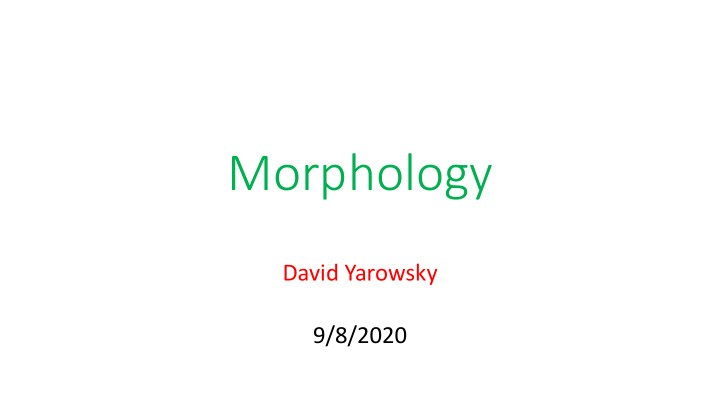



Morphology David Yarowsky 9/8/2020
Acknowledgements and thanks to: • Chris Quirk • Marta Costa-jussa • Richard DeArmond • Eleni Miltsakaki • Antske Fokkens • Penny Eckert • Ivan Sag • Eleni Miltsakaki • Adam Szczegielniak • Jeff Conn • Dan Jurafsky • Jason Eisner
(and factored language models)
Morphological Analysis morphemes or semantic features dogs => dog+s or dog+PL walking => walk+ing or walk+PRS;PTCP running => runn+ing? run+ing & n->nn (gemination) dancing => danc+ing? dance+ing & e->NULL (elision)
Morphological Generation morphemes or semantic features dog+s => dogs or dog+PL => dogs walk+ing => walking or walk+PRS;PTCP => walking run+ing => running or run+PRS;PTCP => runnning & n->nn (gemination) dance+ing => dancing or dance+PRS;PTCP => dancing & e->NULL (elision)
Inflectional Morphology morphemes or semantic features dogs => dog+s or dog+PL <= regular grammatical feature extension walking => walk+ing or walk+PRS;PTCP of same core word meaning (“I am walking” and “I walked” differ only by tense) inflectional paradigm: VERB +PRS;3SG +PRS;PTCP +PST;PFV +PST;PTCP (+s) (+ing) (+ed) (+en/+ed) <= canonical affixes walk walks walking walked walked eat eats eating ate eaten employer => employ+er or employ+V:N(AGT) employment => employ+ment or employ+V:N(RESACT) employable => un+[employ+able] (not able to be employed) [un+employ]+able (able to be not employed)
Inflectional Morphology morphemes or semantic features dogs => dog+s or dog+PL <= regular grammatical feature extension walking => walk+ing or walk+PRS;PTCP of same core word meaning (“I am walking” and “I walked” differ only by tense) inflectional paradigm: VERB +PRS;3SG +PRS;PTCP +PST;PFV +PST;PTCP (+s) (+ing) (+ed) (+en/+ed) <= canonical affixes walk walks walking walked walked eat eats eating ate eaten Derivational Morphology (new concept formation) employer => employ+er or employ+V:N(Agent) “employ” = An ACTION (verb) “employer” = A PERSON (noun) employment => employ+ment or employ+V:N(Result/ActOf) a “dogfight” is not a “dog” employable => un+[employ+able] (not able to be employed) [un+employ]+able (able to be not employed?) <= is “to unemploy ” a verb?
Morphological Segmentation
Morphological Parse
<= Infixation of “ freakin ” morpheme
Morphology for Machine Translation
Morphology at JHU
Collaborators: Faculty: David Yarowsky, Philipp Koehn, Matt Post, Kevin Duh, Jason Eisner Senior Researchers/Postdocs: Christo Kirov, Garrett Nicolai, Oliver Adams, John Sylak-Glassman PhD Students: Winston Wu, Arya McCarthy, Ryan Cotterell, Aaron Mueller, Huda Khayrallah, Patrick Xia Masters/Undergraduates: Nidhi Vyas, John Hewitt, Roger Que, James Scharf Dylan Lewis, Lawrence Wolf-Sarkin, ++
Multi-Source/Multi-Stage Morphology Learning: ➢ Currently available supervised data (e.g. Wiktionary) ➢ Elicited paradigms (professional translators, Mturk) ➢ Seed data from grammars, ITG, linguistic universals ➢ Bilingual projection (e.g. from aligned Bibles) ➢ Monolingual contextual/distributional statistics Complete Learned Paradigms Human Vetting/Improvement Multi-Source Offline Machine Run-time Executables Learning and importable hash tables >> DO THIS FOR 300-1600 WORLD LANGUAGES!
GitHub distribution of Trained Morphological Analyzers AND generators for 903+ languages! (will soon be 1100+) Handling of finer granularity distinctions: Analysis: habl aron -> hablar,PST,[3,PL] (perfective) habl aban -> hablar,PST,[3,PL] (imperfective) Generation: hablar,PST,3,PL -> habl aron , habl aban , … (including probabilities)
UniMorph Feature Schema (dimensions of meaning)
Example UniMorph uses in Information Extraction:
Projection of POS tags and Dependency Parses (English semantic roles identify target cases; nsubj dependencies give Person/Number)
Example Unimorph Output: Tables of English phrasal translations of inflected forms INPUT OUTPUT SpInf SpRoot Unimorph Vector English Template English phrasal inflection comía comer V;IPFV;PST;1;SG I was VBG I was eating comías comer V;IPFV;PST;2;SG;INFM you were VBG you were eating comías comer V;IPFV;PST;2;SG;FORM you were VBG you were eating comía comer V;IPFV;PST;3;SG he/she/it was VBG he/she/it was eating comíamos comer V;IPFV;PST;1;PL we were VBG we were eating comíais comer V;IPFV;PST;2;PL;INFM you all were VBG you all were eating comíais comer V;IPFV;PST;2;PL you all were VBG you all were eating comían comer V;IPFV;PST;3;PL they were VBG they were eating hablaba hablar V;IPFV;PST;1;SG I was VBG I was speaking hablabas hablar V;IPFV;PST;2;SG;INFM you were VBG you were speaking hablabas hablar V;IPFV;PST;2;SG;FORM you were VBG you were speaking hablaba hablar V;IPFV;PST;3;SG he/she/it was VBG he/she/it was speaking hablábamos hablar V;IPFV;PST;1;PL we were VBG we were speaking hablais hablar V;IPFV;PST;2;PL;INFM you all were VBG you all were speaking hablais hablar V;IPFV;PST;2;PL you all were VBG you all were speaking hablaban hablar V;IPFV;PST;3;PL they were VBG they were speaking
GitHub distribution of Trained Morphological Analyzers AND generators for 903+ languages! (will soon be 1100+) Diverse detailed inflectional morphology Nouns: sg/pl and case(nom/acc/dat/gen/loc/other) Verbs: tense(pst/prs/fut) +person/number( 1SG,1PL,2.. ) Adjectives: person/number/case/gender in progress Analysis mode: python analyze.py -i Inflected-Zapotec.txt -a Zapotec.analyses -l zap -d Zapotec-lemma-list Generation mode: python analyze.py -i Zapotec-lemma-list -g -a Zapotec.generation -l zap -d Zapotec-corpus-words
UniMorph (example of currently released languages)
UniMorph Languages (continued)
UniMorph Languages (continued – page #3)
Example Unimorph Output: Tables of English phrasal translations of inflected forms INPUT OUTPUT SpInf SpRoot Unimorph Vector English Template English phrasal inflection comía comer V;IPFV;PST;1;SG I was VBG I was eating comías comer V;IPFV;PST;2;SG;INFM you were VBG you were eating comías comer V;IPFV;PST;2;SG;FORM you were VBG you were eating comía comer V;IPFV;PST;3;SG he/she/it was VBG he/she/it was eating comíamos comer V;IPFV;PST;1;PL we were VBG we were eating comíais comer V;IPFV;PST;2;PL;INFM you all were VBG you all were eating comíais comer V;IPFV;PST;2;PL you all were VBG you all were eating comían comer V;IPFV;PST;3;PL they were VBG they were eating hablaba hablar V;IPFV;PST;1;SG I was VBG I was speaking hablabas hablar V;IPFV;PST;2;SG;INFM you were VBG you were speaking hablabas hablar V;IPFV;PST;2;SG;FORM you were VBG you were speaking hablaba hablar V;IPFV;PST;3;SG he/she/it was VBG he/she/it was speaking hablábamos hablar V;IPFV;PST;1;PL we were VBG we were speaking hablais hablar V;IPFV;PST;2;PL;INFM you all were VBG you all were speaking hablais hablar V;IPFV;PST;2;PL you all were VBG you all were speaking hablaban hablar V;IPFV;PST;3;PL they were VBG they were speaking
UniMorph Gloss Use for Machine Translation
Derivational Morphology
Recommend
More recommend